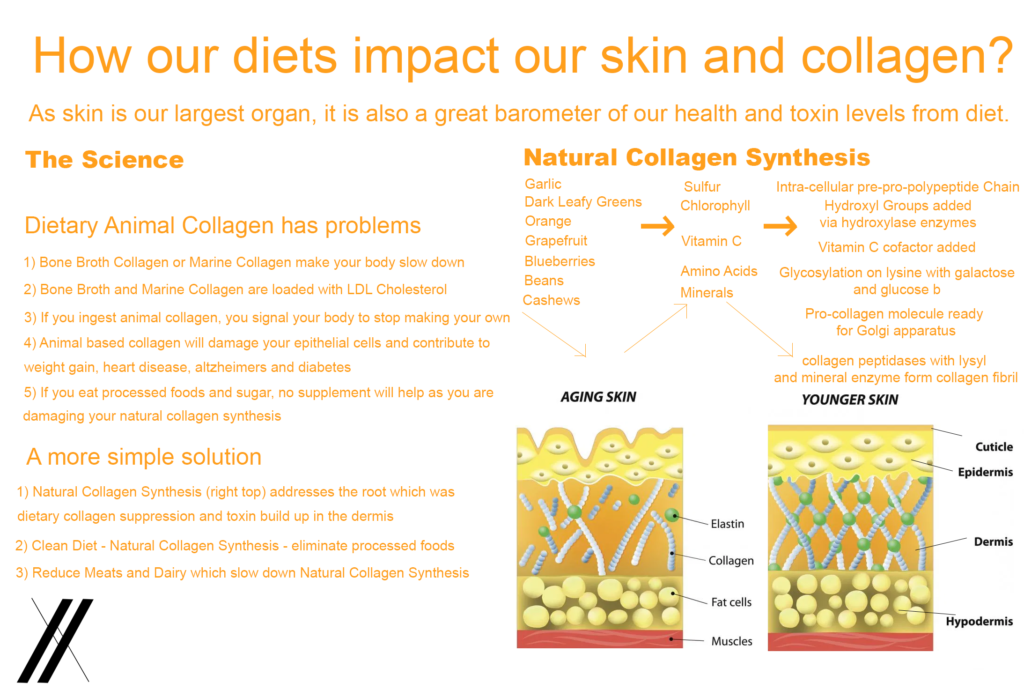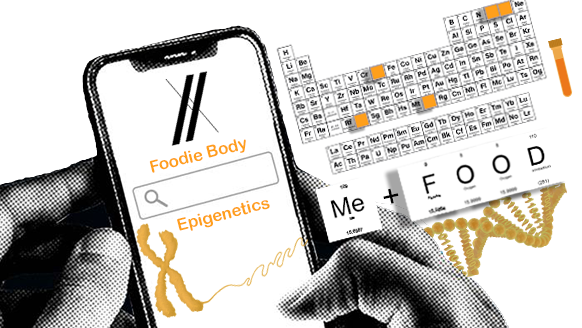How Diet effects our Skin and Natural Collagen Production

Collagen Unpacked
Collagen is the most abundant protein in the human body. Therefore, it can be divided into many types. The most common types of collagen are types I through V each serving different functions.
Contrary to trends in the media, taking “Collagen Supplements” will actually set you back more than before you started and will create a host of additional side effects such as heart disease, Alzheimer’s, diabetes and weight gain.
A more simple approach is addressing the root of aging skin which is dietary collagen suppression. The secret to younger skin is not more supplements, it is simply changing what you eat. Your body is a natural collagen producing machine, but you have to feed it the correct ingredients to be on your way to younger skin and natural collagen synthesis as you had when you were younger before your diet had built up toxins and suppressed your innate ability to produce your own collagen without side side effects.
As illustrated above and below, the dietary ingredients to promote natural collagen synthesis are simple and straight forward.
Cellular chain sequence for Natural Collagen Synthesis
Intracellular
Transcription of mRNA in the nucleus
- Genes for pro-a1 and pro-a2 chains are transcribed
Translation
- mRNA moves into the cytoplasm and interacts with ribosomes for translation.
- After translation, it is referred to as pre-pro-polypeptide chain; this chain then travels to the endoplasmic reticulum (ER) for post-translational modification.
Post-translational modification
Once in the ER, the pre-pro-polypeptide undergoes post-translational processing where three major modifications are made to the pre-pro-polypeptide for it to become pro-collagen.
- The signal peptide on the N-terminal is removed
- The lysine and proline residues get additional hydroxyl groups added to them via hydroxylase enzymes which require vitamin C as a cofactor.
- Glycosylation of the selected hydroxyl groups on lysine with galactose and glucose b.
- Three of the hydroxylated and glycosylated pro-a-chains assemble by twisting into a triple helix by zipper-like folding. The triple helix configuration is 3 left-handed helices twisted into a right-handed coil.
- Now the pro-collagen molecule is ready to move to the Golgi apparatus for final modifications and assembled into secretory vesicles to enter the extracellular space.
Extracellular
Propeptide cleavage
- Enzymes known as collagen peptidases preform propeptide cleavage and remove the ends of the procollagen molecule and the molecule becomes tropocollagen
Collagen Fibril Assembly
- Lysyl oxidase a copper-dependent enzyme acts on lysine and hydroxylysines, and covalent bonding between tropocollagen molecules form a collagen fibril

Recent Developments how epigenetics caused by diet may effect natural collagen production
Robin Holliday defined in 1990 epigenetics as “the study of the mechanisms of temporal and spatial control of gene activity during the development of complex organisms.” Thus, in its broadest sense, epigenetic can be used to describe anything other than DNA sequence that influences the development of an organism.
More recent usage of the word in biology follows stricter definitions. It is, as defined by Arthur Riggs and colleagues, “the study of mitotically and/or meiotically heritable changes in gene function that cannot be explained by changes in DNA sequence.”
A clean diet is important to reduce the risk of epigenetics effecting natural collagen production.
DNA damage
DNA damage can also cause epigenetic changes. DNA damage is very frequent, occurring on average about 60,000 times a day per cell of the human body (see DNA damage (naturally occurring)). These damages are largely repaired, but at the site of a DNA repair, epigenetic changes can remain. In particular, a double strand break in DNA can initiate unprogrammed epigenetic gene silencing both by causing DNA methylation as well as by promoting silencing types of histone modifications (chromatin remodeling – see next section). In addition, the enzyme Parp1 (poly(ADP)-ribose polymerase) and its product poly(ADP)-ribose (PAR) accumulate at sites of DNA damage as part of a repair process. This accumulation, in turn, directs recruitment and activation of the chromatin remodeling protein ALC1 that can cause nucleosome remodeling. Nucleosome remodeling has been found to cause, for instance, epigenetic silencing of DNA repair gene MLH1. DNA damaging chemicals, such as benzene, hydroquinone, styrene, carbon tetrachloride and trichloroethylene, cause considerable hypomethylation of DNA, some through the activation of oxidative stress pathways.
Foods are known to alter the epigenetics of rats on different diets. Some food components epigenetically increase the levels of DNA repair enzymes such as MGMT and MLH1 and p53. Other food components can reduce DNA damage, such as soy isoflavones. In one study, markers for oxidative stress, such as modified nucleotides that can result from DNA damage, were decreased by a 3-week diet supplemented with soy. A decrease in oxidative DNA damage was also observed 2 h after consumption of anthocyanin-rich bilberry (Vaccinium myrtillius L.) pomace extract
Customized Solutions for your body and chemistry
Just as epigenetics can cause issues such as metabolic syndrome, cancer, heart disease, mental disorders, auto-immune disease and diabetes, food can also ameliorate these conditions. To learn more on if the first steps of a plant based whole foods plan are right for you create a free account and review the 30 day Foodie Body plan. There is no charge to participate and the search engine will customize your food results to help improve your independently verified labs. Consult your physician before commencing on a dietary change to ensure it is right for you.
Biochemistry

Reverse Natural Collagen Suppression through diet
CirclesX LLC
a SimpsX Technologies LLC company
12335 Kingsride Lane #418
Houston, Texas 77024
Technical Support (832) 916-2001
Geolocation Exchange Markets and Search

